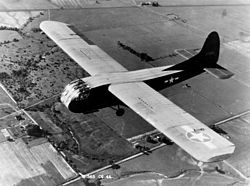Military glider facts for kids

Military gliders are a type of glider aircraft used by armies. Unlike regular planes, they don't have engines. They were mainly used during World War II to carry soldiers and heavy equipment into war zones.
These gliders were pulled into the air by military transport planes, like the C-47 Skytrain. Sometimes, even bombers towed them. Once close to the battle lines, the gliders were released. They would then silently glide down to land on any open ground near their target.
How Military Gliders Worked
Military gliders were designed to land with as little damage as possible. This was important for the cargo and crew inside. However, landing spots were often not ideal. Because these missions were usually one-way, gliders were seen as disposable. This meant they were made from simple and inexpensive materials like wood.
They did not have armor and were quite fragile. They also had basic steering and no brakes. Because of this, many gliders crashed during landing. Soldiers who landed by glider were called airborne infantry. Glider pilots sometimes called themselves "tow targets." Soldiers often called the gliders "flying coffins." Sadly, for some missions, up to 40% of the people involved became casualties.
Advantages of Gliders
Even with their risks, gliders had some important benefits. Paratroopers, who jump from planes with parachutes, often landed spread out over a large area. This made it hard for them to find each other or their equipment, like vehicles or anti-tank guns.
Gliders, however, could land troops and equipment very precisely at a specific spot. Once released from the tow plane, military gliders were very quiet. This made it hard for the enemy to spot them. Larger gliders were built to carry heavy gear. This included anti-tank guns, anti-aircraft guns, small vehicles like jeeps, and even light tanks, such as the Tetrarch tank. This heavy equipment made glider forces much stronger.
During World War II, the United States had about 6,000 trained glider pilots. Some of these pilots were given a second chance to fly gliders if they didn't finish regular plane training. The Soviet Union also tried out ways to drop light tanks from the air. One example was the Antonov A-40, which was a tank with wings that could glide.
Gliders Today
After World War II, helicopters largely took the place of gliders. Helicopters can pick up and drop off soldiers on the battlefield with more accuracy. Also, new technology allows even light tanks to be dropped by parachute. Today, only special forces sometimes use gliders for quiet, small missions.
Images for kids
-
An RAF airman attaches the tow rope of an Airspeed Horsa glider to the tow hook of a Handley Page Halifax glider tug, in preparation for Operation Fustian, Tunisia (July 1943)
See also
 In Spanish: Planeador militar para niños
In Spanish: Planeador militar para niños



